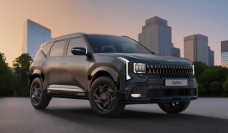
Exterior Redesign: A Subtle Yet Impactful Change
Hyundai has skillfully updated the Tucson's exterior while retaining its core design elements. The facelift version showcases a more refined front grille and bumper, incorporating sleeker LED elements and a robust faux skid plate. The redesigned headlights and air dams now draw inspiration from the Santa Cruz pickup, adding a touch of ruggedness to the vehicle's overall appearance.
Interior Overhaul: A Leap Towards Luxury
The most noticeable changes appear inside the Tucson. Moving away from the design themes seen in models like Creta and Alcazar, the new Tucson adopts a luxurious approach. Its interior boasts dual 12.3-inch screens, a streamlined dashboard with integrated AC vents, and a modern three-spoke steering wheel. This redesigned cabin prioritizes space, style, and comfort, highlighted by lighter upholstery and a more spacious center console.
Performance and Comfort: Balancing Power and Pleasure
The Tucson facelift maintains its impressive dimensions and is expected to continue with its current powertrain options. The 2.0L petrol and diesel engines promise a balance of power and efficiency. The cabin's comfort is enhanced with features like dual-zone climate control, ventilated seats, and advanced connectivity options, including support for Alexa and Google Assistant.
Advanced Safety: Prioritizing Passenger Protection
Safety in the new Tucson facelift is a top priority, with over 45 safety features, including Active and Passive ADAS. This comprehensive safety package ensures peace of mind with features like collision alert, lane-keeping assist, and blind spot detection.
Conclusion: A Promising Entry for the Indian Market
Hyundai's Tucson facelift is a well-rounded package poised to make a significant impact in India's premium mid-size SUV segment. With its refined aesthetics, luxurious interiors, balanced performance, and top-tier safety features, the Tucson is all set to challenge rivals like the Jeep Compass and Skoda Kodiaq.














 Best Diesel Cars Under 15 Lakh in India
Best Diesel Cars Under 15 Lakh in India Best Car Tyres for Indian Roads: Complete Buying Guide
Best Car Tyres for Indian Roads: Complete Buying Guide Top 5 Cheapest Hatchbacks in India Post-GST Cut (2025)
Top 5 Cheapest Hatchbacks in India Post-GST Cut (2025) India's Top 10 Affordable Compact SUVs After GST Reduction (2025)
India's Top 10 Affordable Compact SUVs After GST Reduction (2025)